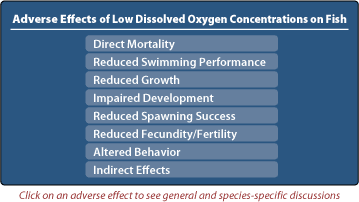Current location: Home > Biological Effects Model > Adverse Effects |
|
Adverse Effects of Exposure to 
This portion of the model examines eight potential adverse effects of low DO concentrations on fish. These effects are listed above.
Introduction
To a certain degree, fish can compensate for low DO concentrations through a number of physiological and behavioral responses that increase oxygen uptake. However, these responses require energy and therefore can restrict the availability of energy for other activities necessary for survival, growth, and reproduction. Certain behavioral responses may also indirectly affect survival, growth, and reproduction by exposing fish to other risks. The severity of these effects increases rapidly as oxygen concentrations approach the incipient lethal level. Below this threshold, the amount of oxygen becomes insufficient to meet the minimal demands for survival (standard metabolic rate), resulting in direct mortality. Different species and life stages of fish differ in their ability to tolerate low DO concentrations, depending on the natural range of DO concentrations that fish typically encounter in their preferred habitats (Rombough 1988; Cech et al. 1990). Species and life stage tolerances reflect adaptations to different environments and differences in metabolic requirements, activity levels, size, and morphology. The early life stages of fish (embryos and larvae) are often more sensitive to low DO concentrations than older life stages (juveniles and adults) of the same species because of their limited ability to detect and avoid low DO concentrations and, in some cases, their higher oxygen requirements. Water temperature can strongly influence the effects of low DO concentrations on fish because increasing temperature increases the metabolic requirements of fish and decreases the amount of oxygen that can dissolve in water. Consequently, changes in water temperature can change the DO concentration thresholds associated with adverse effects; increasing water temperature increases the incipient limiting and lethal threshold concentrations, while decreasing water temperature lowers these thresholds. Thus, seasonal variability in water temperature can be an important consideration in assessing the effects of low DO concentrations on fish. |